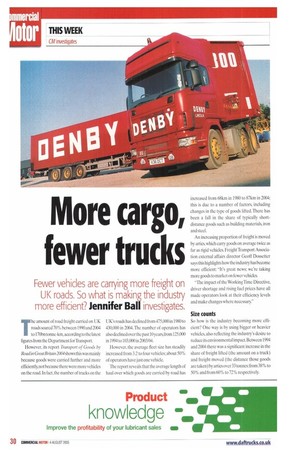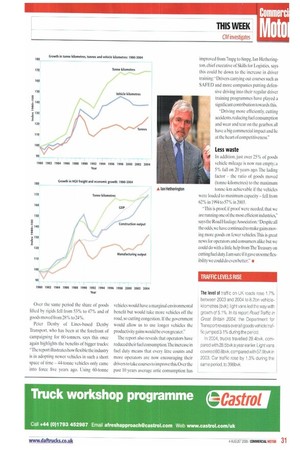More cargo, fewer trucks
Page 30

Page 31

If you've noticed an error in this article please click here to report it so we can fix it.
Fewer vehicles are carrying more freight on UK roads. So what is making the industry more efficient? Jennifer Ball investigates.
The amount of road freight carried on UK roads soared 70% between 1990 and 2004 to 170bn tonne-km, according to the latest figures from the Department for Transport.
However, its report Transport of Goods by Road in GreatBritain 2004shows this was mainly because goods were carried further and more efficiently,not because there were more vehicles on the road. In fact, the number of trucks on the UK's roads has declined from 475,000 in 1980 to 430,000 in 2004. The number of operators has also declined over the past 10 years, from 125,000 in 1994 to 103.000in 2003/04.
However, the average fleet size has steadily increased from 3.2 to four vehicles; about 50% of operators have just one vehicle.
The report reveals that the average length of haul over which goods are carried by road has increased from 68km in 1980 to 87km in 2004; this is due to a number of factors, including changes in the type of goods lifted. There has been a fall in the share of typically shortdistance goods such as building materials, iron and steel.
An increasing proportion of freight is moved by artics, which carry goods on average twice as far as rigid vehicles. Freight Transport Association external affairs director Geoff Dossetter says this highlights how the industry has become more efficient: "It's great news; we're taking more goods to market on fewer vehicles.
"The impact of the Working Time Directive, driver shortage and rising fuel prices have all made operators look at their efficiency levels and make changes where necessary."
Size counts
So how is the industry becoming more efficient? One way is by using bigger or heavier vehicles, also reflecting the industry's desire to reduce its environmental impact. Between 1994 and 2004 there was a significant increase in the share of freight lifted (the amount on a truck) and freight moved (the distance those goods are taken) by artics over 33 tonnes: from 38% to 50% and from 60% to 72% respectively. Over the same period the share of goods lifted by rigids fell from 53% to 47% and of goods moved from 28% to 24%.
Peter Denby of Lincs-based Denby Transport, who has been at the forefront of campaigning for 60-tormers, says this once again highlights the benefits of bigger trucks: "The report illustrates how flexible the industry is in adopting newer vehicles in such a short space of time — 44-tonne vehicles only came into force five years ago. Using 60-tonne vehicles would have a marginal environmental benelit but would take more vehicles off the road, so cutting congestion. If the government would allow us to use longer vehicles the productivity gains would be even greater."
The report also reveals that operators have reduced their fuel consumption.The increase in fuel duty means that every litre counts and more operators are now encouraging their drivers to take courses to improve this.Over the past 10 years average artic consumption has improved from 7mpg to 8mpg. Ian Hetherington, chief executive of Skills for Logistics, says this could be down to the increase in driver training: "Drivers carrying out courses such as SAFED and more companies putting defen ve driving into their regular driver training programmes have played a significant contribution towards this.
"Driving more efficiently cutting accidents, reducing fuel consumption and wear and tear on the gearbox all have a big commercial impact and lie at the heart of competitiveness."
Less waste
In addition, j ust over 25% of goods vehicle mileage is now run empty; a 5% fall on 20 years ago. The lading factor — the ratio of goods moved (tonne-kilometres) to the maximum tonne-km achievable if the vehicles were loaded to maximum capacity — fell from 62% in 1994 to 57% in 2003.
"This is proof, if proof were needed, that we are running one of the most efficient industries," says the Road Haulage Association."Despite all the odds, we have continued to make gains moving more goods on fewer vehicles. This is great news for operators and consumers alike but we could do with a little help from The Treasury on cutting fuel duty I am sure if it gave us some flexibility we could do even better." •




































































































































































































